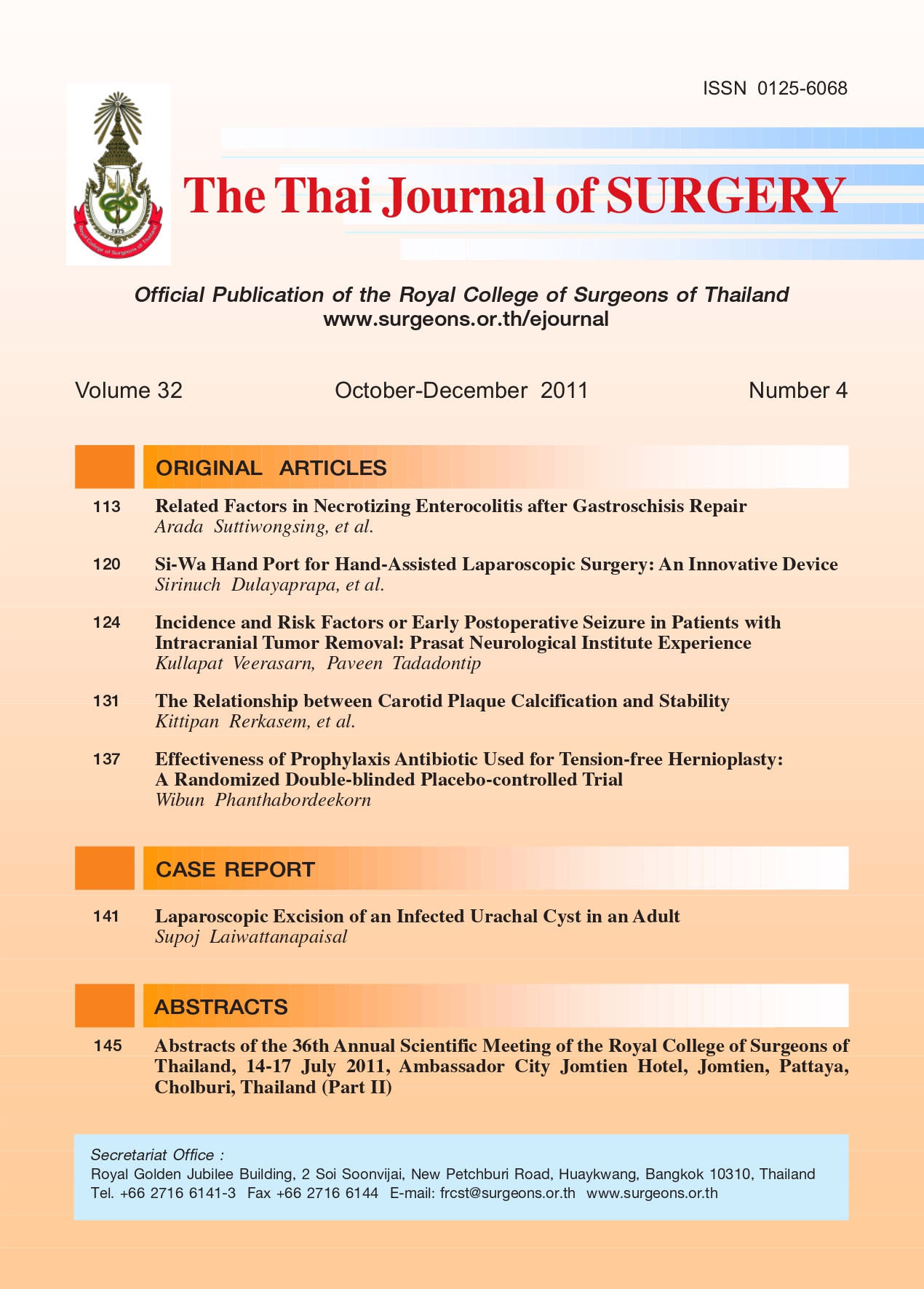Comparative Outcome of Extra-Peritoneal Laparoscopic Technique with Open Technique for Continuous Ambulatory Peritoneal Dialysis
Keywords:
Peritoneal dialysis, Continuous ambulatory peritoneal dialysis, Tenckhoff catheter, Llaparoscopic technique, Open techniqueAbstract
Background: The common problems after performing continuous ambulatory peritoneal dialysis (CAPD)were catheter migration, leakage, outflow obstruction and hemorrhage. There was a study of comparison
between laparoscopic and open technique complications the results of which were 13% and 35%, respectively.
At present, there were many laparoscopic techniques to improve outcome due to minimally invasive nature and
direct visual pathology. The extra-peritoneal method is a good option to reduce complication.
Materials and Methods: The retrospective cohort study was carried out to compare laparoscopic
Tenckhoff insertion via extra-peritoneum and open technique. The patients’ data were collected from January
2010 to January 2012. The operations were performed by two surgeons. Fifty nine patients were enrolled in this
study but three were excluded so the total number was 56 patients. Outcomes at 6 months were analyzed. The
survival of catheter was compared between two techniques. The statistical analysis was performed using a Chisquare
test, Fisher’s exact tests and t-test with p-value < 0.05 as statistical significance. The Kaplan-Meier
survival analysis was used to compare survival rates.
Results: There was no difference in age and gender between two groups. Most patients had underlying
hypertension or diabetes. The comparative data between laparoscopic and open methods in follow-up time
(month), operative time (min) and number of catheter survival after 6 months (%) wer e21±3 vs 10±3, 45±12
vs 19±8 and 89% vs 66% respectively. The complication rates in term of migration, leakage, bleeding and
peritonitis at the first 6 months between laparoscopic and open methods were 0% vs 21%, 0% vs 5%, 0% vs 5%
and17% vs 18% respectively. Only the migration rate of catheter was significantly lower in the laparoscopic
group compared with open technique. However, long-term catheter survival was not different.
Conclusion: The laparoscopic Tenckhoff insertion via extra-peritoneal approach is feasible and effective
in reducing postoperative catheter complications especially catheter migration.
References
presentation of midline incision-lateral placement method
and a review of 110 procedures. Nephrol Dial Transplant
1995;10:386-90.
2. Moreiras Plaza M, Cuina L, Goyanes GR, Sobrado JA,
Gonzalez L. Mechanical complications in chronic peritoneal
dialysis. Clin Nephrol 1999;52:124-30.
3. Bannister K, Watson D, Pearce T. Clinical and cost benefits of
laparoscopic catheter insertion for continuous ambulatory
peritoneal dialysis (CAPD). Kidney Int 1997;51:1328.
4. Özener ç, Bihorac A, Akoglu E. Technical survival of CAPD
catheters: Comparison between percutaneous and
conventional surgical placement techniques. Nephrology
Dialysis Transplantation 2001;16:1893-9.
5. Gadallah MF, Pervez A, El-Shahawy MA, Sorrells D, Zibari G,
McDonald J, et al. Peritoneoscopic versus surgical
placement of peritoneal dialysis catheters: A prospective
randomized study on outcome. Am J Kidney Dis 1999;33:
118-22.
6. Harissis HV, Katsios CS, Koliousi EL, Ikonomou MG, Siamopoulos
KC, Fatouros M, et al. A new simplified one port laparoscopic
technique of peritoneal dialysis catheter placement with
intra-abdominal fixation. Am J Surg 2006;192:125-9.
7. Li JR, Wu MJ, Chiu KY, Yang CR, Chen CJ, Cheng CL.
Concomitant laparoscopic peritoneal dialysis catheter
placement and total extraperitoneal hernioplasty: A case
report. Peritoneal Dialysis Int 2010;30:580-1.
8. Mellotte GJ, Ho CA, Morgan SH, Bending MR, Eisinger AJ.
Peritoneal dialysis catheters: A comparison between
percutaneous and conventional surgical placement
techniques. Nephrology Dialysis Transplantation 1993;8:
626-30.
9. Nissenson AR, Gentile DE, Soderblom RE. Morbidity and
mortality of continuous ambulatory peritoneal dialysis:
Regional experience and long-term prospects. Am J Kidney
Dis 1986;7:229-34.
10. Comert M, Borazan A, Kulah E, UÇan BH. A new laparoscopic
technique for the placement of a permanent peritoneal
dialysis catheter: The preperitoneal tunneling method.
Surgical Endoscopy and Other Interventional Techniques
2005;19:245-8.
11. Tsimoyiannis ECT, Siakas P, Glantzounis G, Toli C, Sferopoulos
G, Pappas M, et al. Laparoscopic placement of the
Tenckhoff catheter for peritoneal dialysis. Surgical
Laparoscopy, Endoscopy and Percutaneous Techniques
2000;10:218-21.
12. Soontrapornchai P, Simapatanapong T. Comparison of open
and laparoscopic secure placement of peritoneal dialysis
catheters. Surgical Endoscopy and Other Interventional
Techniques 2005;19:137-9.
13. Borazan A, Comert M, Ucan BH, Comert FB, Sert M, Sekitmez
N, et al. The comparison in terms of early complications of a
new technique and percutaneous method for the
placement of CAPD catheters. Renal Failure 2006;28:37-42.
14. Warunyuwong C. Percutaneous Bedside versus Surgical
CAPD Catheter Placement. J Chonburi Hosp 2011;36:121-
124.
Downloads
Published
How to Cite
Issue
Section
License
Articles must be contributed solely to The Thai Journal of Surgery and when published become the property of the Royal College of Surgeons of Thailand. The Royal College of Surgeons of Thailand reserves copyright on all published materials and such materials may not be reproduced in any form without the written permission.


